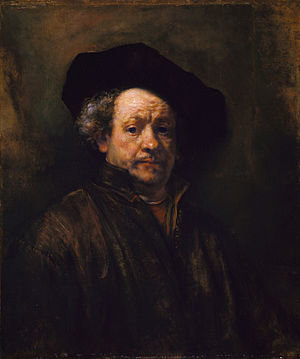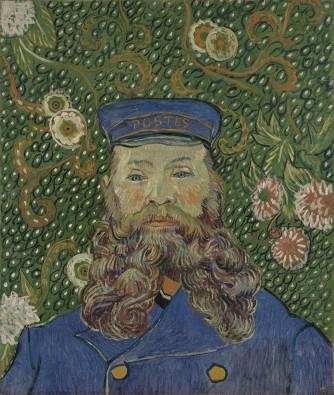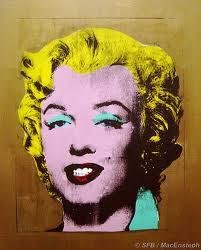Introduction
Typically, painted images are full of clues regarding the historical and cultural context. They also carry the message regarding the interest and abilities of the artist. In fact, they always depict the person in the image. Visual analysis of works of art involves keen observation of the details painted by an artist from formal and narrative contents of the work.
Visual analysis involves interpretation, description and evaluation of the portrait by focusing the attention to yield significant information regarding the work of art. The information obtained is important in making comparisons between different portraits. This study explores formal and narrative content of Rembrandt’s Self-Portrait 1660, Vincent van Gogh’s Portrait of Joseph Roulin 1889 and Andy Warhol’s Gold Marilyn Monroe 1962.
Thesis Statement
Rembrandt’s Self-Portrait 1660, Vincent van Gogh’s Portrait of Joseph Roulin 1889 and Andy Warhol’s Gold Marilyn Monroe 1962 differ in entirety regarding the messages sent by pose and facial expressions and the utilization of the painting frame.
Rembrandt’s Self-Portrait 1660
The portrait was created in 1660. Rembrandt used oil on canvas nine years prior to his demise. The portrait features no other individual. This is significant given that it implies the depth of privacy the artist valued. However, considering the direction of the eyesight, he seems to be looking at another person albeit missing from the frame.
He appears to be looking at somebody else as a patient. His face is red-dotted with signs of rosacea. Besides, the dots may be a stylistic devise commonly used by the artist in his previous works of art. In the portrait, the artist’s eyes appear normal. The left eye is to some extent narrower than the right eye.
The eyes do not indicate any signs of palpebral ptosis or a pterygium. The bright line seems to suggest he was ailing from arcus senilis. The latter eye depicts healthy individuals happy with the inner self and heath. The faces of the Monroe and Roulin radiate contentment with their lives. Closer observation of the face reveals that the lit line is a mirror image of the cornea.
Most of his other paintings also contain the reflection of the cornea. In paintings such as Vincent van Gogh’s Portrait of Joseph Roulin 1889, this effect is not evident, as Roulin’s eyes appear dull. In fact, they do not reflect any light although there is abundant light that may have reflected considering that his eyes are wide open. In the Gold Marilyn Monroe 1962 portrait, Monroe’s eyes are also open and white around the iris.
However, the sufficient light that illuminate the image do not reflect. Her eyes seem to absorb every ray of light. While Rembrandt’s eyes seem to suggest his inner soul, the latter images appear to consume the light.

Figure 1: Rembrandt’s Self-Portrait 1660 .
The image depicts sign of aging of Rembrandt. The skin is lightly colored compared to other self-portraits painted previously. The skin illustrates signs of senile degeneration. The dullness of his clothing merges with the background.
In contrast to portraits of Roulin and Monroe, the background seems to swallow the artist while the latter appears to dominate the frame directing the attention of the audience details of the figures as opposed to outrightly focusing on the face.
Vincent van Gogh’s Portrait of Joseph Roulin 1889
The portrait depicts Roulin clad in a blue uniform he constantly wore pompously as a postal employee in Arles Southern France. The artist wrote to his brother Theo of his thrill regarding “the contemporary portrait”. This picture rendered quality not by the simulation of the sitter’s look, but through the autonomous and bright verve of color. His subject in this image is Joseph Roulin. The portrayal was drawn when Roulin got a better job.

Figure 2: Portrait of Joseph Roulin 1889 .
Dressed in a blue uniform, the image is set on a background with creative surroundings of whirling flowers. Gogh typically did not paint people, but concentrated on natural elements such as landscapes, sunflowers and wheat fields. Rembrandt painted many individuals that he felt were worth remembering. Apart from his self-portrait, Gogh painted Roulin given that he was his close friend (Gutierrez 1).
The frame reflects a dark, yet peaceful mood. However, Rembrandt’s frame is full of dullness and gloomy mood. The peaceful mood of this frame is indicative of satisfaction within Gogh given that he had found greener pastures. The darkness of the frame is indicative of the sadness Gogh felt in his soul due to the departure of Roulin from Arles for a better-paying job. The color of the eyes is dull.
It implies that Roulin was also sad to leave his friend behind when he left. However, the pose indicates that Roulin was proud of his new status. The cap is positioned squarely on his head like a disciplined forces personnel with the label ‘posts’ clearly visible. This indicates that Roulin was proud of his work.
Discipline forces personnel typically shave the beards. In the image, Roulin has long beards. This is illustrative of the freedom from any authority to do as he wishes. He is under no obligation to look in accordance to anyone’s wishes. Gogh believed in using colors to express his feelings. In this portrait, the background is multicolored with green dominating.
The color is a representation of spiritualism of the artist who believes in the eternity of humanity. In fact, it is the illustration of the platonic belief in an ideal world. The eternal world lies ahead of his friend even as he moves away from Arles. Unlike in other portraits that lack flowers, the flowers used in this portrait are representations of life. The curls of the flowers seem to suggest that life is not always smooth given that there are multiple challenges which humanity has to contend with throughout.
Roulin’s beard is curled while Monroe only the hairs are curled. Rembrandt’s Self-Portrait shows no such curls. The flow of the curves in Roulin portrait mimics the background swirls of the flowers. This is an indication that the artist believes that Roulin possess eternal life just as flowers. In addition, the curls guide the eyes of the audience through the painting in a harmonious way.
The viewer can easily pick details without the eyes dilating and contracting frequently. The frame does not have any shadow of the image yet the frame appears to illuminate since fine details are observable. This means that the figure is lit from all directions. Gogh believed that Roulin was righteous. Hence, the light came from all directions. He had no soul blemishes.
Andy Warhol’s Gold Marilyn Monroe 1962
Warhol as an artist was unique regarding the techniques he applied to produce his work of art. His techniques had not been observed previously in the world of art. Rembrandt and Gogh applied techniques that had been used previously. The rich mix of colors is not apparent in the latter artists’ work. Typically, the artist would combine drawings with photography.
In Monroe’s frame, the face is centralized and small with the background occupying most of the frame. The latter’s frames are significantly occupied by the images. He would paint silk-screened canvases with pictures using abstract colors. Regularly, he utilized his own photos.
However, he occasionally used pictures of other artists whenever he desired to depict a matter that he would never have a chance to take a snap. Gold Marilyn Monroe 1962 is one such portrait. Indeed, it depicts the face of a young woman. The portrait is silk screened onto a canvas.

Figure 3: Gold Marilyn Monroe 1962 portrait
Visually, very modest of her dressing can be seen on the image. This is founded on the tight cropping of the painting. Besides, the image appears to be wearing a dress that is tied at the back of the neck. This is illustrative of the changing trends in the dressing code. Similar to Roulin portrait showing the newly acquired status, the Monroe image gives the impression that women had undergone significant stages in acquiring freedom not only in dressing, but also in the liberation from male dominance.
Monroe hair has been trimmed short. However, it appears to fall very near the head, but underneath the ears. The impression implies that despite the fact that women are gradually gaining liberation from male dominance, men still have relative authority above women.
The falling of the hair indicates that women still stoop to men irrespective of the freedom they have acquired as gender factors in order to make the distinction between men and women apparent. In the Roulin’s case, the beard is indicative of authority of the male gender. The beard is more of a ‘mane’ than a beard and seeks to demonstrate masculinity.
The background of the frame is golden. This is a reference to the Byzantine Icons. In fact, it seeks to illustrate that Warhol was very conversant with the icons considering the Christian and religious upbringing in his childhood. This was noth the case in Rembrandt and Roulin’s Portraits. By incorporating gold in the image, the artist sought to indicate that the familiarity he had with Christianity was similar to the familiarity Monroe had with iconography in pop spheres.
Typically, Byzantine spiritual paintings are meant to facilitate praying. The perception created by this element eliminates the necessity of the background from that of Christianity and naturalistic that renders to the adoration of human. Warhol transfigures Monroe into a religious symbol founded on byzantine through the appropriation of techniques similar to those used in the Christian and religious context.
The artists painted a small image at the center of a huge frame on the golden canvas background. It is hardly proportional to the entire size of the composition. This eliminates the setting and loss of a sense of time from the composition. When ballooned, the image is distorted and un-naturalistic unlike in other portraits.
Considering that, the portrait was painted immediately after Monroe committed suicide, the artist sought to capture the attention of the audience to contemplate about the glamour. The portrait is multi colored. The artist aimed to capture the attention of the audience to the bizarreness of Monroe’s identity. Monroe seemed to live a dual lifestyle where she fitted in the traditional society as well as the emerging pop society.
The gold background may imply the traditional society to which Monroe managed to disengage herself from in totality. However, the society considered her part of it not only as a member but also as an icon that they could look upon always. The many colors on the image of Monroe indicates the uniqueness of her multiple personalities that she had during her lifetime.
Conversely, the other two portraits denote the specific person’s states of affairs. Roulin is contented since he has been offered a better-paying job while Rembrandt is going through some form of illness. The icon would fit in any societal setting irrespective of culture. Her personality attracted people of all races, gender and age.
By using commercial technique of silk-screening, Warhol gives the image a crisp and synthetic look despite his canonization of Monroe. This reveals Monroe’s public figure as a cautiously planned illusion of who she really was. Her position as a pop icon was not her natural individual. In fact, it was a creation of the changing times and flexibility to fit in a changed society.
Her teeth are white as they are in real life indicating that despite the transformation she had undergone to fit in the changing pop society, she still had elements of traditional culture embedded in her because of her upbringing. The latter portraits are concerned neither with the societal affairs nor with the individuals’ pasts.
Conclusion
The three works of art are similar in the sense that they all feature facial expressions of people. They communicate their moods and the experiences they are undergoing at the time of painting except for Gold Marilyn Monroe whose image and the coloring denote life experiences of the past.
The portraits have more differences than similarities regarding the theme they seek to express. Monroe portrait’s theme is about the society; Gogh’s is about the inner soul and state of health while Roulin is about happiness with achievements.
Works Cited
Gutierrez, Antonio 2012. Portrait of Joseph Roulin by Vincent van Gogh 1889. May 2012. Web.
Osaka, David 2013. Rembrandt. February 2013. Web.